The Students and the Sphinx
Posted on: 21 January 2022 by Kim Fisher, VG&M Visitor Services in 2022

In our previous VG&M building history blogs, we have looked at the construction and opening of the Victoria Building so now we delve into the Sphinx Magazine to find out what the students really thought of their brand-new building.
“The Victoria Building is well-adapted for its purpose, satisfactorily warmed and ventilated and it sufficed for all central needs.” – College Council
College Council Reports
After the Victoria Building opened, the College Council noted that the common rooms and reading rooms were now excellent facilities and the lecture theatre was being used for student entertainments, public lectures and public meetings, providing much more space than the old college building.
In his own section of the report, Principal Rendall stated “The completion of the Victoria Building had completely changed the working conditions of student life.”
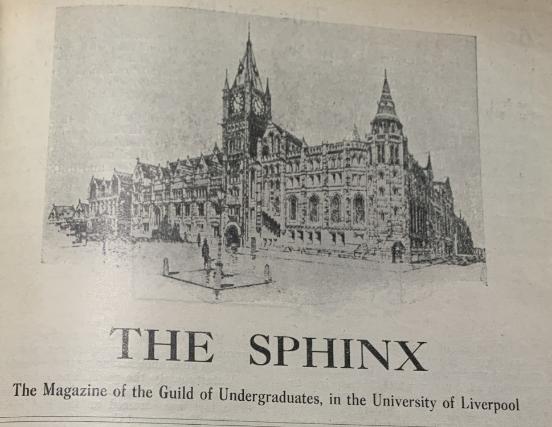
The student Sphinx Magazine, 1 July 1926, University of Liverpool Special Collections & Archives.
The Sphinx and Shivering Students
But what did the students think? Thanks to candid opinions and articles written in The Sphinx magazines, we can see whether the official reports really lived up to student expectation and reality.
One student writing in October 1893 may have disagreed with the council’s report as they entitled their article ‘Wanderings in search of warmth.’ They had gone to the Tate Library in search of a warm place to study only to find that after an hour, the temperature was around 3 degrees, and they were significantly colder than when they first entered the building when wearing a thick coat.
The student consensus was that as the library was part of a new building, the heating should be considerably warmer than in the old college and something needed to be done about it.
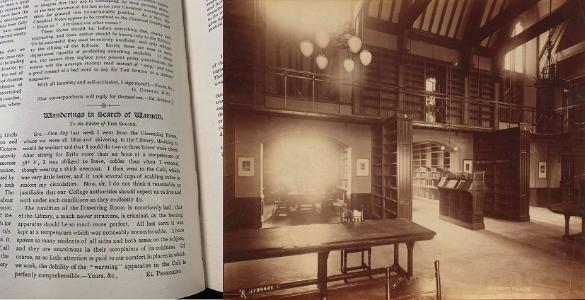
1893 extract from Sphinx Magazine and photograph of the Tate Library circa 1892
It appears conditions hadn’t improved as in 1894, the temperature in the Tate Library was still an issue:
“Sir, I am one of those misguided mortals who thinks that they work in the Tate library …Have you ever tried to work there? You go there shortly after 10 in the morning. Though the atmosphere is clammy and cold. A strong disposition to work comes upon you and shivering slightly, you open your books in a side alcove reflecting that there are very many pipes, which might under circumstances, over which students have limited control, contain hot water in a few minutes.”
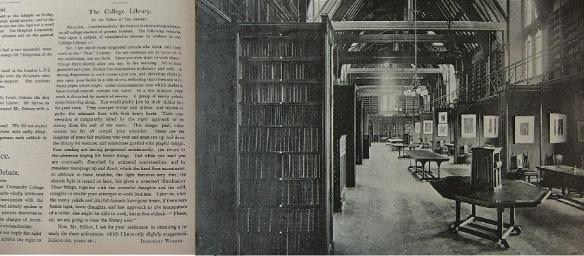 Extract from Sphinx Magazine and photograph of the Tate Library circa 1892.
Extract from Sphinx Magazine and photograph of the Tate Library circa 1892.
A further complainant during the same year continued the sentiments for both the insufficient temperature and lighting arrangements in the library:
“… the lights becomes very dim. The electric light is turned on later but gives a wretched illumination. These things together with powerful drafts and in the cold conspire to render your attempts to work fruitless…if there were better light, fewer drafts and less approach to the temperature of a cellar, one might be able to work…”
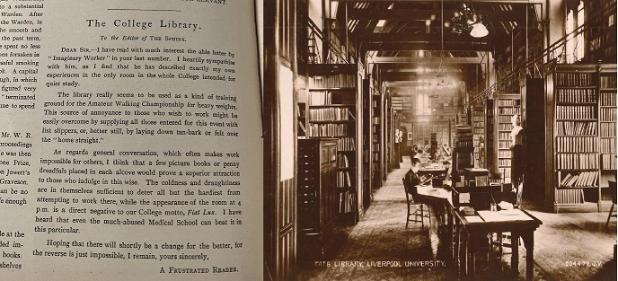
Extract from Sphinx Magazine and photograph of the Tate Library circa 1892.
Another student called ‘Frustrated Reader’ responded to these comments and added:
“The coldness and draughtiness are in themselves suffice to deter all but the hardiest from attempting to work there, while the appearance of the room at 4pm is a direct negative to our college motto ‘Fiat Lux’ (let there be light).”
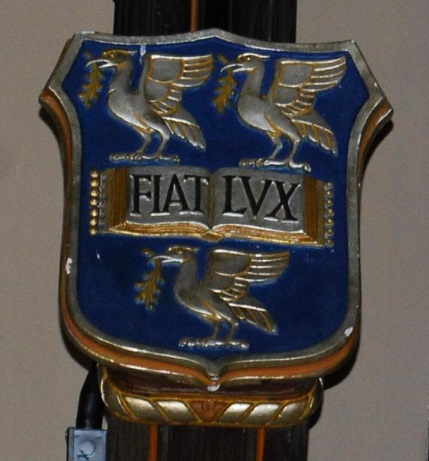
University of Liverpool ‘Fiat Lux’ shields in the Tate Hall
The council had reported that the reading rooms were excellent, however the female students commented in their section of the magazine that their reading room during the winter months was cold and dreary so it appears that the whole building did have issues with inadequate heating. The common room had a fireplace that the ladies often sat round but the reading room next door was heated by the cast iron radiators, and although they look ornate, they didn’t provide much warmth in the large room.
In the summer months however, the reading room was welcoming and bright and one of their favourite places in the building so there was some positive feeling towards their new accommodation.

The common room and reading rooms that were used by the female students from 1892.
Grim and Grimy
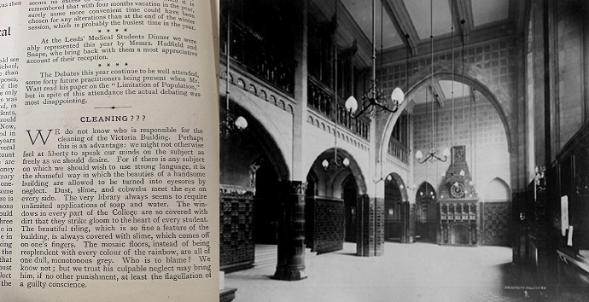
Extract from Sphinx Magazine and photograph of the entrance hall circa 1892
The students also complained that the building was always covered in dirt and grime and the windows needed constant cleaning. Soot from the coal fires would have coated the interior of the building and as an industrial Victorian city, the outside of the building would also have been affected by dirt and grime. However, window cleaning such a large building was no easy task in the 1890s as this photograph shows.
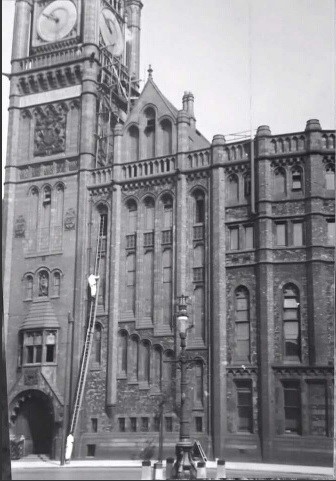
Window cleaning at the Victoria Building.
A Lavish Lecture Space
The Arts Lecture Theatre does seem to receive more praise than other areas of the building.
An article published after a student soiree stated that the Victoria Building was particularly well fitted for such functions and that when it is lit up and filled with people and evening dress, it was so fine that you could excuse inattention to the music being performed.
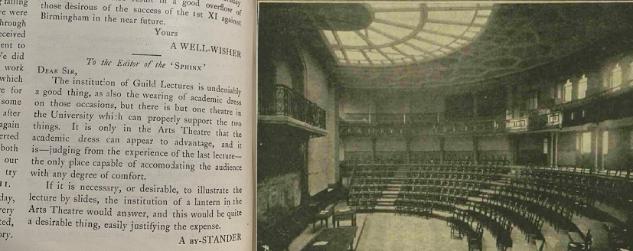
Extract from Sphinx Magazine and photograph of the Lecture Theatre circa 1892.
In 1917 a student gave a humorous account of examinations taken within the Arts Theatre that Principal Rendall had helped design especially for examinations with removable tiers stating:
“I stumble up to a narrow platform, by way of narrower steps, constructed ages ago by men of the narrowest minds…A sound of tumbling or stumbling down those narrow stairs attracts my attention. It is merely an insignificant wretch doing the goose step to obtain more paper.”
Even today we advise our brides to bring their wedding shoes and practise their entrance down these stairs toward the aisle because of their unusual arrangement.
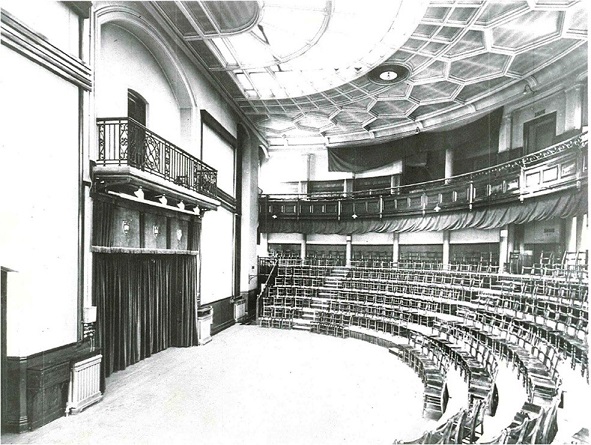
The Lecture Theatre circa 1892.
Architecture and Attitudes
“Having passed through the period when people imagined that the Victoria building represented the highest achievement of the human brain in the art of architecture. I'm pretty sure to meet with agreement, if I condemn the mantelpiece of the Great Hall, the inscription on the front of the building, the pedestal of the Bushell statue, the windows of the men's reading room, and the desks in the history classroom.” – Student Magazine
Later accounts in 1907, 15 years after the building was constructed, shows how fashions and attitudes had already changed in relation to architectural designs. A student stated that the redbrick work of the Victoria Building did not impress them and the whole building struck them as a somewhat unworthy home for the most cultured enterprises of a dignified city. Its architectural design seemed nondescript, its fabric regrettable, and the total effect lacking dignity.
The inside also disappointed this fresher as they had expected something finer for the entrance hall and thought the tiles and colour to be incredibly ugly.
In fact even Charles Reilly, the Professor of Architecture from 1904 – 1933 hated Waterhouse’s Victorian Gothic design and described it as “mud and blood architecture.”
In a 1909 student article the glazed brick interiors are compared to a station subway with an unsightly tower and in 1913 a German visitor mistook the quadrangle and surrounding buildings as factories for the working class, much to the horror of the student showing him around.
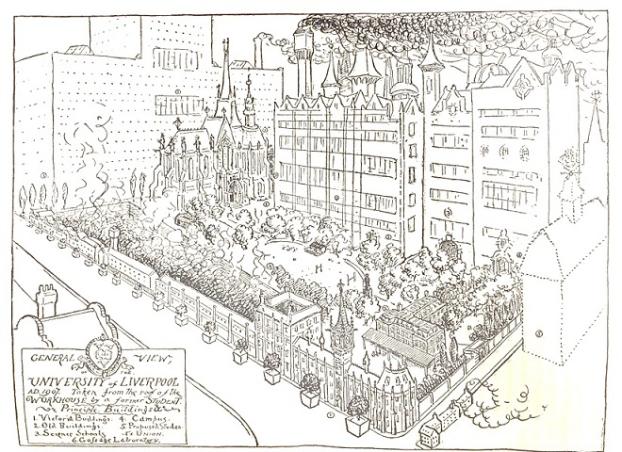
Sketched view from 1907 showing the University of Liverpool campus, Victoria Building, old asylum and gardens.
However, there are some positive reviews from the students too. In 1893, the students wrote an article praising their magnificent new building and comparing its many welcome new additions compared to the dilapidated old building.
There are poems and songs that show a fondness for their college building stating how nothing can excel the gleaming halls and corridors and how the alumni looked back fondly on their building.
Perhaps many of the later students, writing after the old asylum had been demolished, had nothing to compare the new building to. Many of these student accounts from the college magazine were written tongue-in-cheek and may have exaggerated minor issues for a few laughs amongst the student readers.
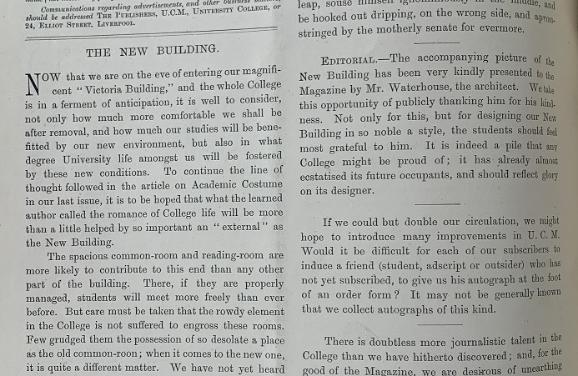
Extract from the 1893 magazine, praising Waterhouse & the new building.
Thankfully the building is now a lot warmer, cleaner and brighter than it was in its heyday. We no longer have soot from the large fireplaces covering the building with dirt and the addition of modern electric lighting and additional heating has helped provide a much more inviting atmosphere.
Several spaces in the building are still used by our students today including the lecture theatre and café area, especially in 2020 when more socially distanced study spaces were required during the pandemic. It has been lovely to welcome them back to the original building and have them studying in these spaces once again.
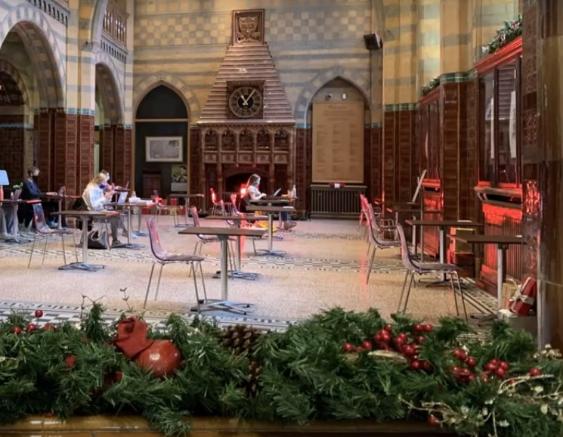
Students studying in the Waterhouse café in 2020 during the pandemic.
Ultimately architectural styles come in and out of fashion. Today our building attracts a lot of positive comments, but what do you think of the Victoria Building?
Keywords: Students, Sphinx Magazine, Alfred Waterhouse, Special Collections and Archives, Victoria Building, University of Liverpool , University College Liverpool.